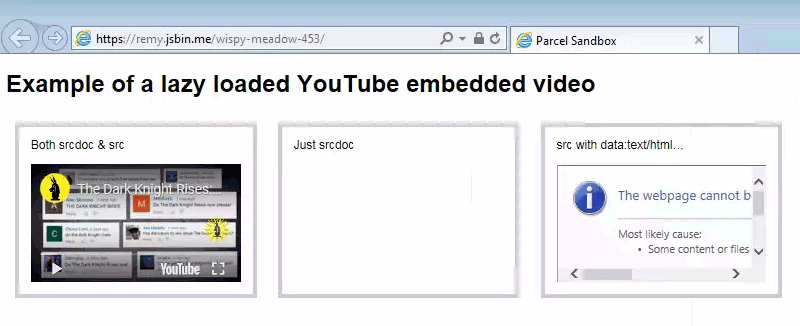There's a great pragmatic post on dev.to (that Jeremy's link feed put me on to) on how best to embed youtube on your site, specifically to avoid the amount of scripts and tracking that's sent over the wire to your visitor.
The trick Arthur Corenzan uses in their solution is to use srcdoc to let the visitor click through to an embed version of the youtube video.
But then there's the IE11 visitor…

MY EBOOK£5 for Working the Command Line
Gain command-line shortcuts and processing techniques, install new tools and diagnose problems, and fully customize your terminal for a better, more powerful workflow.
£5 to own it today
Support
Myself, I've got a long and potted history with iframes (with JS Bin and many other tools) so when I see srcdoc being used I'm always partially pleased and partially sceptical.
A quick check on caniuse shows that srcdoc is well supported. Opera Mini has no support, but that's to be expected (as it's a proxy-type browser) then it's IE11 and all Microsoft Edge versions prior to Microsoft's move to Blink as their render engine.
What does that mean for this srcdoc trick? Well, it means there's no meaningful link to follow. IE11 sees an iframe, but renders it empty.
Does IE11 matter? It shouldn't, but it does. My own blog, a technical and personal website still gets about 1.5% of traffic from these Microsoft browsers (oddly IE11 is the largest chunk). If this method were a progressive enhancement I wouldn't worry about it, but the content is simply inaccessible to the browser and the visitor.
The fix thankfully is simple though there's a consideration that I'll return to. As per the W3 specification:
If the
srcattribute and thesrcdocattribute are both specified together, thesrcdocattribute takes priority. This allows authors to provide a fallback URL for legacy user agents that do not support thesrcdocattribute.
That's to say: reintroduce the src attribute and it all works again.
There is another trick that you might have considered and that's to use data:text/html… on the src property. I tried that (instead of using srcdoc) and IE11 has a bit of a wobbly over it, so it's not viable.
Here's IE11 (from browserling.com) rendering my tweaked version of Arthur Corenzan's work:

This works but there's an ethical consideration: do you penalise users with old browsers?
The first is that the older browser is sent more bytes (and thus CPU processing) than the newer browsers. I'm going to guess there's a correlation between age of browser and age of machine it's running on too. That means users with older browsers are penalised.
The flip side is that before Arthur Corenzan's srcdoc trick, those users were doing the same amount of work. So arguably their experience hasn't changed. Minimum requirement: works as it always did 👍